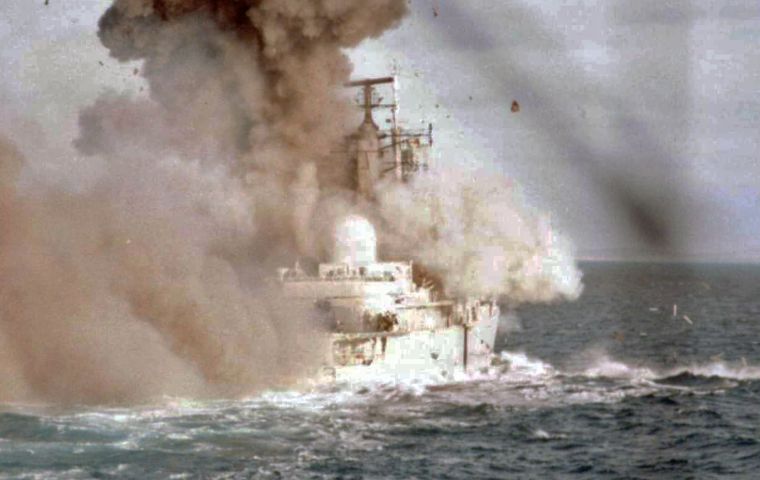MercoPress. South Atlantic News Agency
Operation Blackleg to recover sensitive information from HMS Coventry sunk by Argentine bombers
 Type 42 destroyer HMS Coventry, sunk by an Argentine Air Force A-4 Skyhawk on May 25, 1982
Type 42 destroyer HMS Coventry, sunk by an Argentine Air Force A-4 Skyhawk on May 25, 1982 The Daily Express going through the National Archives of the British Ministry of Defense unearthed details of a secret operation in the aftermath of the Falkland Islands War to recover what were considered sensitive information and weapons, fearing they might fall into the hands of curious Soviets roaming the area.
According to Callum Hoare, Operation Blackleg, involved a saturation diving team, tasked with salvaging the wreck of Type 42 destroyer HMS Coventry, sunk by an Argentine Air Force A-4 Skyhawk on May 25, 1982. The attack took the lives of 19 sailors and injured a further 30 – with the ship, and many of its important contents, sinking in just 20 minutes.
A memo found by Express.co.uk at the National Archives from the Ministry of Defense (MoD) stamped January 25, 1983, reads: “HMS Coventry was sunk in some 100 meters of water to the north of the Falklands Sound.
“Although too deep for casual, amateur diving, the wreck is accessible to professional divers and it was, therefore, necessary to recover classified cryptographic material. And this was done by Naval divers operating from chartered vessel Stena Seaspread, which is now returning to the UK on completion.”
The mission was undertaken between October 13, 1982, and January 2, 1983, as fears swirled that the Soviet Union could get their hands on sensitive information.
It saw the team secure various weapons such as the Sea Dart missile and recover items including coded documents, the captain's ceremonial sword and telescope, as well as the Cross of Nails from Coventry Cathedral, presented in 1978 when the ship was commissioned.
Four decades later, lead diver Ray Sinclair, who personally cut into the captain's safe to recover top-secret NATO documents, has penned his incredible first-hand account for Express.co.uk.
”Our Naval Party 2200, aboard the Dive Support Vessel (DSV) Stena Seaspread, had reached its destination. The ship is stationed 13- miles North of West Falkland Island in the tempestuous South Atlantic Ocean. Directly below us, 300 feet down, laying on her port side, was the wreck of the Royal Navy’s Type 42 Guided Missile Destroyer, HMS Coventry“.
Operation Blackleg was the codename given to recovering NATO sensitive equipment and documents.
Command, in a scene reminiscent of a James Bond film and spoken with the seriousness of “M,” informed the divers, “If we fail to recover or destroy all the items on the Ministry of Defense list, NATO would be set back by 25 years.”
According to Ray Sinclair, as a Royal Navy Clearance Diver and with the help of a Remotely Operated Vehicle, ROV, the mission was successful in recovering the crypto tapes from the Computer Room. With the Computers Room successfully cleared, the following task was clearing Captain Hart-Dyke’s cabin. The primary aim was to open the safe and recover the top-secret documents.
As happened with the Computer Room, which demanded making a hole in the hull to access inside, with the safe something similar happened since the combination would not open the small chest size safe, and oxy-arc cutting gear was necessary. The documents marked TOP SECRET were recovered as well as other beautiful silver ornaments. This dive also brought up the much revered “Cross of Nails”, and captain Hart-Dykes ceremonial sword and telescope, were recovered.
The final dive of the team was to the Sea Dart missile launcher. 50lb charges were placed on the ship's superstructure at strategic locations. The Stena Seaspread moved off station. All three charges detonated.
For 30 years, due to the Official Secrets Act, only the MODs sanctioned accounts of the dives were allowed to be reported. With no credit whatsoever given to the Leading Divers who accomplished the bulk of the dangerous, harrowing and demanding work. Now, 40 years on, Express readers have a factual retelling of the events.




Top Comments
Disclaimer & comment rulesCommenting for this story is now closed.
If you have a Facebook account, become a fan and comment on our Facebook Page!